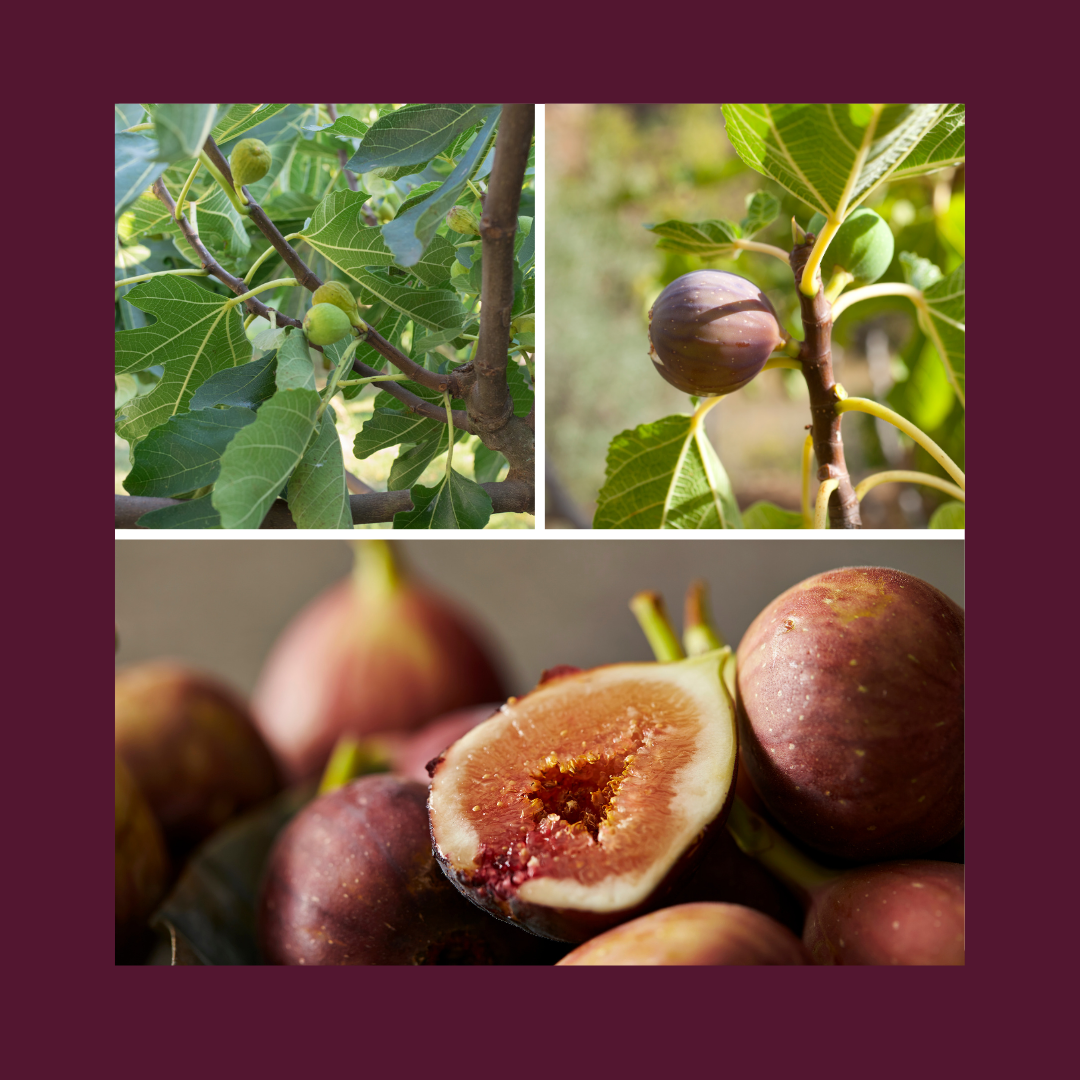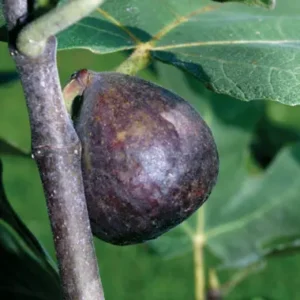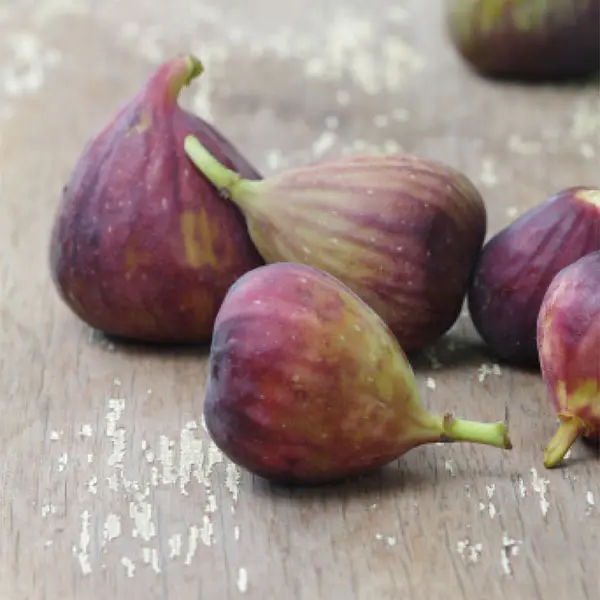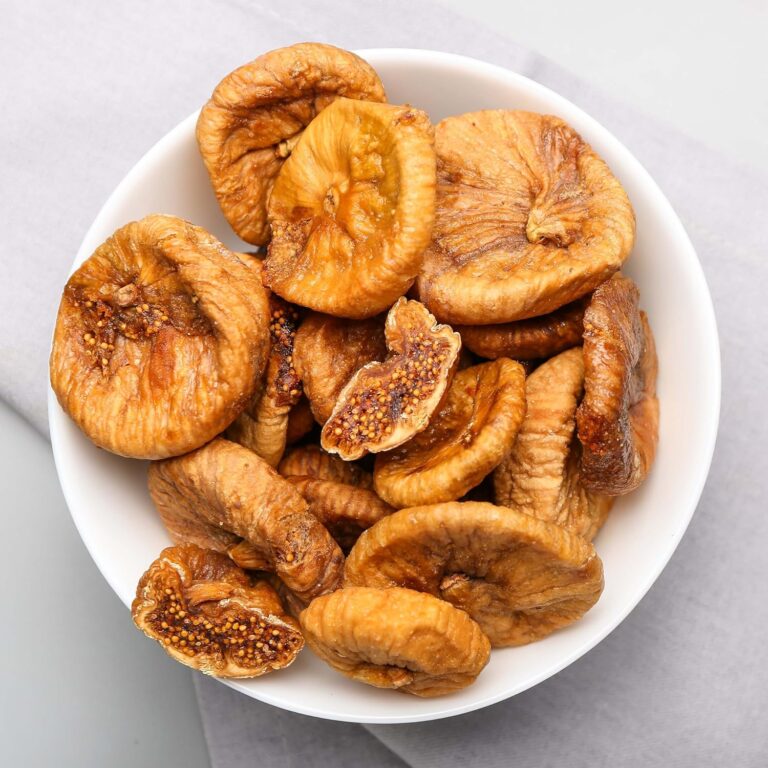
“There are two main fig varieties found in Mississippi: Celeste and Southern Brown Turkey. Celeste is the most common variety found in the state. It is generally small, pear-shaped, light brown to violet-bronze with a pink pulp and has a sweet taste. Southern Brown Turkey figs are medium-sized with light brown skin and a mild, sweet flavor.” Mary Michaela Parker, Mississippi State Extension

Brown Turkey Fig
Image Credit: Stark Brothers
Why grow a Brown Turkey Fig?
“The Brown Turkey Fig tree is known for producing medium sized sweet fruit that ripens to a brown, reddish-purple color. This variety is known for being an all-around quality fig, enjoyable for eating and good for preserving, making it one of the favorite fig trees for home gardeners.
“This is the perfect plant to accent your patio—with the bonus of fresh figs! Enjoy attractive flat, lobed leaves and tear-dropped shaped green fruit that darkens when ripe. Planting in containers will allow this fig to be grown in cooler hardiness zones, so long as the fig is brought indoors during the winter months.
Overwintering Fig Trees in Cooler Climates
“If you experience temperatures below freezing, then additional winter protection is necessary for best results.
“Potted figs should be placed in an insulated, unheated, preferably dark room or cool basement. Water them monthly until just moist so the roots do not dry out completely.
“For fig trees planted in-ground, insulate as much as possible by getting creative. Use chicken wire and burlap or surround with straw bales stuffed with leaves. The pliable branches can be bent in to preserve as much as the plant as possible. What is not covered, will likely die back. Figs fruit on new growth and the insulated roots will send out new growth, even if the top dies.
“Fig trees, ficus carica, tend to be low maintenance. The Brown Turkey Fig may yield two distinct crops in locations with long, warm growing seasons. It is self-pollinating and heat-tolerant. When temperatures drop below 10°F, protect the tree by wrapping it in burlap.” Stark Brothers
-
Average shipping height – 1g 8-12 inches, 3g 16-24 inches [Plants Direct]

Celeste Fig
Image Credit: Stark Brothers
About Celeste Fig Trees
“The Celeste Fig tree, sometimes called Celestial or Sugar fig, is known for producing delicious, sweet fruit with rose colored to violet skin. This variety is more cold hardy than most other types of figs and is a favorite to grow in California and throughout the southeastern United States. It is also heat tolerant.
“This tree is known for being pest and disease resistant. It is a closed eye fig, meaning the small hole that naturally exists at the apex of the fruit is closed, keeping out natural pests like wasps. Having a closed eye, the Celeste Fig can produce more ripe fruit that doesn’t spoil during the growing season.
Using the Fruit and Leaves
“Figs have been a favorite fruit tree since Classical times, loved for their sweetness and rich flavor. They are enjoyable to eat fresh and can be used in salads, charcuteries, and with cheese. Chefs use their sweet flavor for desserts, and they can be dehydrated, canned, and frozen.
“Figs are a good source of fiber, calcium, iron, potassium, and magnesium. They are also high in vitamins A and C.
“Even the leaf is a source of food from this productive tree! The leaves are broad and flat, with a distinctive lobed shape. They are often used for grilling, steaming, and baking, where they impart a smoky flavor to other foods. Additionally, the dehydrated leaves can be made into tea.” Stark Brothers
The Health Benefits of Figs
“Deciduous tree growing to 13 ft (4 m). Has large leaves and fleshy receptacles that ripen into purple-brown, pear-shaped fruit.Fig’s pulpy flesh is emollient and soothing to inflamed skin.
Habitat & Cultivation
“Native to western Asia, fig now grows wild and is cultivated in many temperate and subtropical regions. Fruit is harvested in summer.
History & Folklore
“The fig leaf was used by Adam and Eve to hide their nakedness in the Garden of Eden. There are many other references to the plant in the Old Testament, mainly to the sweetness of the fruit and to its use as a medicine. Spartan athletes in Ancient Greece were said to eat figs in order to improve their performance.
Medicinal Actions & Uses
“The fruit sugars within the fig (especially the dried fruit) have a pronounced but gentle laxative effect; syrup of figs is still a remedy for mild constipation. The fruit’s emollient pulp helps relieve pain and inflammation, and it has been used to treat tumors, swellings, and gum abscesses—the fruit often being roasted before application. Figs are also mildly expectorant and,….” Chevallier, Andrew. Encyclopedia of Herbal Medicine, pgs. 211-212.

Dried Figs
Image Credit: Yupik on Amazon
Dried Figs
Fresh figs are a delicacy. They are not readiy available to purchase in grocery stores, and fig trees only produce figs for a short period of time. But very few people have access to to a fig tree. When fresh figs are not availabe, dried figs are a substitue, albeit a poor substitute, for the fresh fruit.
“Dried figs are a healthy snack that contain fiber, antioxidants, and other nutrients. They can be eaten whole in salads, diced, or sliced in half with a walnut. Here are some of the health benefits of dried figs:
-
Fiber
“A single serving of dried figs provides 20% of your daily fiber target. Fiber can help reduce the risk of cardiovascular disease, obesity, and type 2 diabetes. It also helps diversify your gut microbiome, which can help build a strong barrier in your GI tract that blocks unhealthy compounds and allows healthy nutrients through.
-
Prebiotics
“Figs are a good source of prebiotics, which can improve gut health.
-
Calcium and potassium
“Figs are a good source of both calcium and potassium, which can work together to improve bone density and prevent conditions like osteoporosis.
- Sugar “Although figs are sweet, their high fiber content can help slow down the impact on your blood sugar level.” Google ai
Dried Figs Can be Rehydrated in Hot Water
I like eating dried figs, just as they are, but they can be reconsituted by pouring some boiling water over them an allowing them to set 2 to 4 hours, Cover the fruit while it is being rehydrated.
Although the process will take longer, you can also rehydrate figs by covering them with vodka and placing them in a cool, dry place for 2 to 3 days.
Discover more from Jacki Kellum
Subscribe to get the latest posts sent to your email.